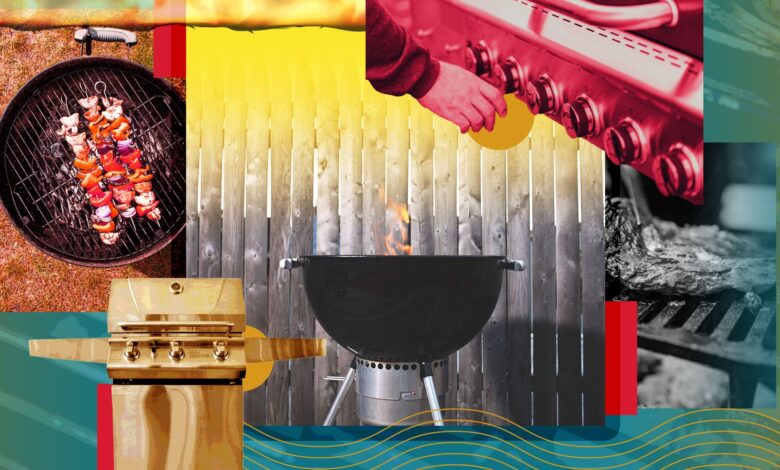Buying a Grill in 2024 Is Soul-Crushing. This Cooker Solves Everything.

GRILLING AND I, we hit a pretty rough patch six years ago.
Before then, we were close. I spent time assembling and testing all sorts of outdoor cooking devices for Men’s Health. During the warmer months, nearly all of my dinners came char-broiled, flame-kissed, or slow-smoked. The grill was a place I could unwind, cold drink in hand, surveying my yard and sighing with satisfaction. I guess you could call it love.
Then, not suddenly, but slowly, the feelings started to fade. At first (and as much as I hate to admit this) I blamed my kids. As new fatherhood sapped me of my energy, the ritual of grilling—the gathering, the transporting, the coal-lighting, the temperature regulating—felt like another reason I would need a nap I could never take. But when my kids got older, and I grew (marginally) less tired, I blamed myself.
Two years ago, for a Fourth of July party, I made burgers on a Weber Original Kettle I had bought a summer prior and hardly ever used. After the patties had been sizzling on the grates for what I thought was a long time, I started sliding them onto buns and serving them. To every griller’s greatest horror, friends began to show me the insides of their raw burgers. (Turns out, ash backup had prevented proper airflow—a boneheaded mistake that stemmed from my being woefully out of grilling practice.)
I’d lost my touch. How did this happen?
It was only until about a month ago that I realized one reason I didn’t feel connected to grilling anymore had nothing to do with my kids—or even myself. One big reason I didn’t love to grill was because of the current state of the grill industry itself.
The Current State of the Grill Industry
Outdoor cooking, as a business, is the strongest it has ever been. An amazing 80 percent of U.S. homeowners have at least one grill or smoker in their possession, which is up from 64 percent in 2019, according to the latest data from the Hearth, Patio, & Barbecue Association (HPBA). The pandemic pushed more people to cook at home, which fueled grill and smoker purchases, according to the HPBA.
And current retail projections continue to look fire. Valued at $2.5 billion in 2023, the U.S. barbecue grill market is expected to grow at a rate of 4.9 percent, with growth in all categories—gas, electric, and charcoal—through 203o. For a market where the vast majority of people already own a grill, that pacing is all the more impressive.

Some of that sustained interest comes from the sheer diversity of products available, which ironically, also is the reason I gradually lost interest in new grills. Fifteen years ago, your big choice when it came to grilling was gas or charcoal. Now you have to choose among pellet grill/smoker hybrids, kamado-style grills, flat-tops, pizza ovens, barrels, electric units, WiFi-enabled rigs, and so much more. Brands like Traeger, PK Grills, Monument, Blackstone, Blaze, and 50 others I’m forgetting have come up to challenge the mighty Weber.
And—as a further sign of de-stabilization in the grill market—even Weber, king of grills itself, briefly faltered in an IPO debacle that resulted in an equity firm taking it private in 2022. The ordeal left some corners of the internet grumbling that Weber’s product quality and customer service had suffered. (I reached out to Weber for comment on these grumbles, but the press team has yet to reply.)
So there I was, dissatisfied with my current grilling experiences, yet stymied by a dizzying array of new grill types and brands. I hadn’t enjoyed my experiments with tech-enabled cookers and was tired of tossing another cheap-o grill from a big box store into the metal pile at the recycling center at the end of every grilling season. So, I had decided that it was going to be just me and my pans—indoors—and I was (becoming more) okay with that.
And I found comfort in knowing that I wasn’t alone.
“I think once pellet cookers, which were the first pieces of outdoor equipment to come with WiFi about 10 years ago, went mainstream it was sort of the end of the basic, analog charcoal or gas grill,” says Sal Vaglica, a gear writer who has done extensive grill testing for the likes of Serious Eats, Food & Wine, and the Wall Street Journal. “If you’re a Gen-X buyer, you sort of grew up with this stuff, but anyone older is going to be in for quite a shock if they’re looking for new gear and haven’t bought a grill since the early 2000s.”
That was me—a guy who just wanted to put flame to food, not fiddle with a Bluetooth connection, special-order brand-specific pellets, or have yet another reason to look at my phone. But then, just as I had started to heal, I was rescued from my discontent and reminded of a grill so beautiful, so powerful, and ultimately so simple, that it would do everything to rekindle my passion for grilling all over again.
The Incredible, Unbeatable Egg
When Big Green Egg offered to send me their Large Big Green Egg to test, I was kind of surprised.
The company is celebrating its 50th birthday this year. Both Weber (officially Weber-Stephens Products) and Big Green Egg started in the 1970s and each brand has taken dramatically different paths.

Weber is everywhere, BGE is only in select retailers. Weber markets-markets-markets, BGE seems cool with just hanging back. Weber has diversified into countless styles, BGE is, well, big and green and shaped like an egg.
What did Big Green Egg feel like it needed to say?
“Grilling is about family, friends, and neighbors. We want to get the word out about how the [Big Green Egg] can help to bridge the gap with the loneliness epidemic,” says Dan Gertsacov, who became the CEO of Big Green Egg in 2023.
He’s not bullshitting, either. “People are emotionally and socially connected to our products,” Gertsacov says. He’s heard from the spouses of men involved in neighborhood BGE cooking clubs, who have told him that without their club, they wouldn’t have friends. He keeps a record of how many times a Big Green Egg shows up in someone’s obituary. (No, really.) People who love their Big Green Eggs refer to themselves, appropriately enough, as “Eggheads.” Gertsacov equates “breaking bread” with “sharing BBQ.”
All of this may sound like complete hooey to you. I was skeptical, but I had played around with a Mini Big Green Egg years ago and remembered what a different and incredible product it was.
Whether it’s a Mini or the Large, all Big Green Eggs largely operate the same: A coal-fed fire, nestled within a ceramic insert, can stoke incredibly hot temps and hold heat for a long time. Lid closed, the domed shape can act as an oven or, when you toss wood chunks or chips on the fire, a smoker. It’s simple—and that’s the entire point.
I could sense the Egg’s beautiful simplicity even before I cooked on it. Assembly, which with other grills is usually a frustrating and infuriating battle with flimsy washers and tiny screws, instead felt like a master class on quality manufacturing with an attention to strength and detail. A felt fabric gasket ring ensures a safe and tight seal. Tightly wound band coils assist in opening and close the lid. The Large Egg, assembled, weighs a formidable 162 pounds. I’d never felt joy piecing together anything that wasn’t a Lego set before, yet there I was, smiling as I constructed my Egg.
And then I cooked on it. In an attempt to redeem myself from that July 4th two summers ago, I first made burgers. Over a steady fire, cold drink in hand, surveying my yard as I listened to everything sizzle, I was cautiously optimistic.
“This is the best burger I’ve ever had,” my son told me at the dinner table that night.
“Like, that I’ve made?” I said.
“No, like ever.”
Over the next several weeks I cooked more burgers, asparagus, pizza, chicken wings, and more burgers. I grilled three nights in a row one week—a streak I hadn’t sustained in years. Each time I grilled, the food came off supremely delicious. And with each success, I heard from some dormant part within myself: This is fun. This is rewarding. I kind of love this.

I loved that the Big Green Egg was analog. (BGE does sell app-assisted products; they’re an accessory feature, not standard. You opt-in, if you want, and if you don’t, the results are still sublime.) I loved that the Big Green Egg was powerful. (Some critics claim it retains heat too long, to which I respond: huh?). I loved that the Big Green Egg seemed worth it.
“If you’re after a reliable, dependable, long-lasting outdoor cooker, you have to go for quality materials and workmanship, which usually means spending a few more bucks,” says Dave Joachim, a recipe developer and author of Grill School, Mastering the Grill, and other cookbooks.
A Large Big Green Egg runs $1,100—and that’s just for the Egg itself. Dealers can be tough to find, too, but Gertsacov says it’s intentional that you can’t find Big Green Eggs on Amazon. “Licensed dealers are there to bring you knowledge of the product and something online retailers can’t: customer service,” Gertsacov says.
If all that seems like a lot, I’d argue that the initial investment you make in an Egg will slowly pay for itself. Like Vaglica says: “Home centers and hardware stores are also carrying private labeled cookers so you’ll see these in person, at a great price, and think it’s a great option—only to roll it to the curb after Labor Day.”
Buy four semi-disposable $300 big box cookers over time and you’ve already surpassed what you’ve spent on a Large Egg that will last you long after your obituary. But there’s another intangible you acquire with an Egg—someone no one has ever been able to put a price on.
Love.


